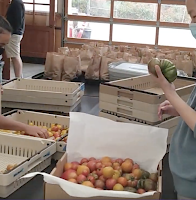 |
| The UW Farm is a 1.5 acre student-powered urban farm & educational facility located on the University of Washington’s Seattle Campus. |
In the past month I finally had the opportunity to volunteer with the University of Washington Farm. I'm proud to say, even in the city of Seattle, college students can learn how food is grown and then processed for food banks, UW campus dining, and community Supported Agriculture (CSA) boxes.
 |
| Sorting tomatoes for CSA bags |
 |
| A boar tomato I was able to bring home |
I learned there are two types of tomato plants: determinate and indeterminate (potatoes, too!). Determinate (bush) tomato plants are bred to stop growing usually somewhere around 3′-4′ feet tall. When flowers blossom at the tips of the branches, the plant has reached its full height.
Indeterminate tomato plants are tall and require staking or caging as they keep growing taller and taller all season. They produce fruits
over a long period and in tropical climates or heated
greenhouses, produce continuously. When grown outside they’re usually mid-season to late
types.
 |
| Source |
It was a great experience, though I'd expected to be able to wear gloves for harvesting and it took days to get dirt out from under my nails. 😀
 |
| Unsplash |











No comments:
Post a Comment